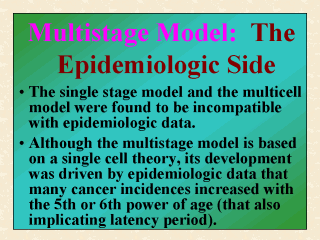 |
The single stage
model proposed by Iversen and Arley (1950) is perhaps the earliest quantitative theory of
carcinogenesis. At about that time, some investigators were intrigued by the fact (see,
e.g., Dong, 1984; Lilienfeld and Lilienfeld, 1980) that many cancer incidences in the
adult human population increased proportionally with the 5th or 6th power of age, a
variable supposedly implicating latency period. The single stage model is unable to
account for the power law relationship, however, given that it assumes a single transformation
rate throughout the course of carcinogenesis. Fisher and Hollomon (1951) attempted to
explain this relationship with a multicell theory, which assumes that a certain number and
concentration of different cells must assemble in a single tissue in order for a
tumor to develop. However, the concentration dependence relationship as conceived in the
multicell model was likewise found to be incompatible with epidemiological data. Another
new theory, which appears to prevail to this date, was then proposed by Muller (1951) and
Nordling (1953) to account for the aforesaid age-dependence relationship. The
Muller-Nordling model is basically a single cell theory. This version assumes that only a
single cell will give rise to a tumor after the cell has suffered (exponentially) a number
k of sequential, heritable changes a, each at a different occurrence rate,
and hence is referred to as the multistage model. According to Armitage and Doll (see,
e.g., 1954), the multistage model asserts that the background incidence rate B(t)
= (a1a2 . . . ak)tk-1,
where t is the age or time at which the tumor becomes visible. |
